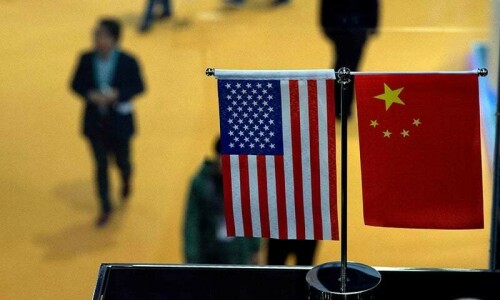ISLAMABAD: From Liaquat Bagh to Parliament House, the supporters of Mumtaz Qadri left a trail of smoke and debris in their wake as they marched on the capital.
Citizens of the twin cities, meanwhile, were confined to their homes in the absence of up-to-date information about the movement of the protesters due to a lack of coverage on electronic media.
Qadri’s chehlum was held at Liaquat Bagh, where speakers including Sarwat Qadri of the Sunni Tehreek called on participants to march towards Islamabad.
Protesters demand release of Sunni prisoners, want Mumtaz Qadri declared martyr
Marchers were stopped by police at Chandni Chowk, where they retaliated and injured a number of law enforcement personnel. They were intercepted again at Shamsabad, where police used tear gas to deter them. However, the marchers pushed on, making it to Faizabad, where they moved the containers blocking their path and entered the capital.

City Police Officer Israr Ahmed Abbasi and Waris Khan DSP Zaman Raza were injured in clashes with protesters here. Around 1,000 people were booked and over a dozen were injured, the CPO told Dawn. “We are considering imposing Anti-Terrorism Act (ATA) Section 7 (which deals with creating terror and violence in society) on these protesters. A case has not been registered yet but consultations with legal experts are underway,” he said.
Once they entered Islamabad, the protesters had a clear path to the Red Zone. On their way, they torched the metro bus station at China Chowk and torched motorcycles and vehicles, damaged private and public property in Blue Area and tried to break the grills of the metro bus track.
Any policeman unfortunate enough to get in the way of the protesters was also badly beaten.
The retreating police kept firing a steady stream of teargas canisters at the advancing mob. This made it difficult to breathe and many people were seen gasping for breath. But the protesters seemed to be on top of things and certain individuals distributed salt, water and gas masks to protesters so they could cope with the effects of the teargas.
Rawalpindi-resident Kamran Hussain, who claimed to be a police official and former member of the Muslim Students Federation, told Dawn that the protesters had been peaceful, but it was the police that forced them to turn violent.

He claimed police opened fire at unarmed protesters. This enraged the mob, which then turned on the police officers. However, a police official, who was not authorized to speak on the record denied that police had fired live rounds on protesters.
“As many as 22 Rangers, police and FC personnel were injured when protesters pelted them with stones and beat them with sticks,” he said.
Another protester, Mazhar Iqbal, who is an FSc student, told Dawn he had come to Islamabad with 16 other people from Sialkot.
“We came here because we want to atone for our sins and prepare for the afterlife. We will not go back unless our demands are met,” he said.
Mohammad Farhan said he had come from Rawalpindi, but was forced to go back because of the intense teargas shelling. “If protest continues, I will come back to D-Chowk to show solidarity,” he said.
The leaders of the protest, meanwhile, kept using abusive and derogatory language for media persons, saying that they were not on hand to provide them coverage.
The protesters at D-Chowk also released a set of 10 demands to the media. Issued under the banner of the Tehreek-i-Labbaik Ya Rasool (SAW), the statement claimed that Pakistan’s Islamic identity was being threatened and that “an agenda to secularise Pakistan is rapidly taking shape”.
The demands included the unconditional release of all Sunni clerics and leaders booked on various charges, including terrorism and murder; the recognition of Mumtaz Qadri as a martyr and the conversion of his Adiala Jail cell into a national heritage site; assurances that the blasphemy laws will not be amended; and the removal of Ahmadis and other non-Muslims who had occupied key posts. They also demanded the execution of blasphemy accused Aasia Bibi, the woman former Punjab Governor Salmaan Taseer was killed for defending.
Published in Dawn, March 28th, 2016















































